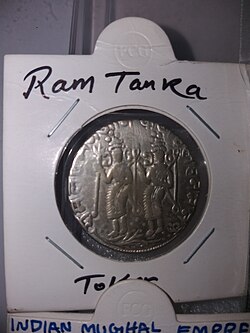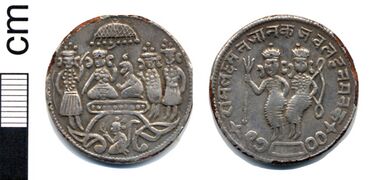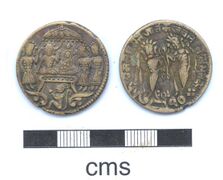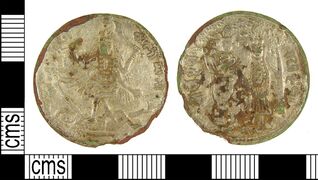Religion:Indian temple tokens

The Indian Temple tokens are token coins popular at temple and pilgrimage sites in India. They are also known as Rama-tankas ("Rama coins"), as several of them feature the Hindu deity Rama. Other names for these coins include ram-tenki, ram-tanka, and ram-darbar.
History
The earliest of the Rama-tankas may have been actual coins (not token coins or medals). The coins issued by the 12th century Chahamana king Vigraharaja IV can be considered as a precursor of the later Ramatankas.[1] The earliest extant mention of the Rama-tankas can be found in the Dravya-Pariksha (1318) of Thakkar Pheru, a mint-master of the Delhi Sultanate. Pheru describes the gold coins known as Sita-Rami.[2]
Historically, the coins appear to have been used for exchange. For example, a record from the Vijayanagara Empire mentions that "10,080 Rama-tanki varahas, 2000 Lakshmi-pati varahas, and 10,050 Puttalikas" were spent on the foundation of a new village called Kunidi. Thakkar Pheru also suggests that the rama-tankas were used for exchange, when he states that if a Sita-Rami coin is "ten mashas in weight and ten ban gold, it is worth being kept for worship and not to be exchanged."[3]
Common styles
A series of gold Rama-tankas, originating in the Vijayanagara Empire, feature the scene of Rama's coronation. These coins are now used as objects of worship in the modern Indian homes.[4]
-
A silvered copper-alloy Rama-tanka depicting Rama's coronation on one side, and Rama-Lakshmana on the other side
-
A silvered copper-alloy variant depicting Rama's coronation on one side, and Rama-Lakshmana on the other side
-
A silver coin depicting Kali on the obverse, and Krishna-Radha on the reverse
A popular silver token, found at Ayodhya and other pilgrimage centres of north India, features images of Rama and Lakshmana with a legend on the obverse, and depicts Rama's coronation on the reverse side.[5] On the obverse, Rama and Lakshmana are depicted wearing a dhoti, both wearing crowns, and holding a bow on their left arms. Rama is shown with a trident in his right hand. The legend surrounding them reads Rāma Lachamana Jānaka java(ya)ta Hanamānaka ("Victorious are Rama, Lakshmana, Sita, and Hanuman"). The tokens also bear a date that reads 17 śana 40, which probably means Vikrama Samvat year 1740, that is, 1683 CE. On the reverse, Rama and Sita are shown on a throne, under a chhatra. They are flanked by Lakshmana on right, Bharata and Shatrughna at the left, and Hanuman at bottom.[6] A variant of this token shows tridents in the right hands of both Rama and Lakshmana, and bears the date 517-40, which may refer to the year 51740 of a fictitious calendar era.[7]
The Rama-tankas are generally associated with Rama, but similar temple tokens featuring other deities also exist. For example, a silver token that probably originated at the Jagannath Temple in Puri, features the triad worshipped at the temple.[5] The obverse depicts the triad (Jaganatha, Subhadra, and Balarama) standing, with the Sanskrit legend śrī-śrī-Jagannāthasvatrayi ("the Jagannatha triad") in Devanagari script. The reverse features Rama's coronation scene; variants with the 517-40 date also exist.[8]

Temple tokens not featuring Rama at all also exist.[5] For example:
- A brass token from the Bengal region features the goddess Kali on one side, and Radha and Krishna on the other side.[5] The obverse features the four-armed Kali standing on the chest of Shiva, and wearing a necklace of skulls. The legend Kali-mata ("Mother Kali") occurs in both Bengali and Devanagari scripts. The reverse depicts Krishna playing flute, with Radha to his left; both stand on a lotus, under a kadamba tree.[8] The legend Rādhā-Kṛṣṇa occurs in both Bengali and Devanagari scripts.[9]
- A silver token depicts Krishna and Radha in a dana-lila scene (in which Krishna asks gopis for tribute to let them pass) on the obverse, with a legend around it. The reverse features depicts Krishna as a cowherd driving four heads of cattle by a kadamba tree, with a legend all around.
- A brass token features Hanuman flying with a mountain (depicted as a triangular object) in his right hand, and a gada (mace) in his left hand, on the obverse. The reverse features a magic square of 9 numbers; the sum of each row and column is 15.[9]
- A silver token features a cow on the obverse, with the Devanagari legend 152100 (probably the year of an imaginary calendar era, to present the coin as an ancient one). The reverse features a four-armed Lakshmi, sitting cross-legged on a lotus. This depiction of Lakshmi appears to be a 19th-century adaption of the one featured on the coins of Chandragupta II.[10]
References
- ↑ P. L. Gupta & A. M. Shastri 1993, p. 201.
- ↑ P. L. Gupta & A. M. Shastri 1993, p. 202.
- ↑ Anthony J. Evensen 2007, p. 155.
- ↑ T. Desikachari 1991, p. 76.
- ↑ 5.0 5.1 5.2 5.3 D. C. Sircar 2005, p. 254.
- ↑ D. C. Sircar 2005, p. 255.
- ↑ D. C. Sircar 2005, pp. 255–256.
- ↑ 8.0 8.1 D. C. Sircar 2005, p. 256.
- ↑ 9.0 9.1 D. C. Sircar 2005, p. 257.
- ↑ D. C. Sircar 2005, p. 258.
Bibliography
- Anthony J. Evensen (2007). Warrior-king, Sʹiva-Bhakta, deity: reconsidering Rāma at Vijayanagara. University of Wisconsin—Madison. https://books.google.com/books?id=TqpxAAAAMAAJ.
- D. C. Sircar (2005). Studies in Indian Coins. Motilal Banarsidass. ISBN 978-81-208-2973-2. https://books.google.com/books?id=m1JYwP5tVQUC&pg=PA253.
- Numismatic Digest. Numismatic Society of Bombay. 1993. https://books.google.com/books?id=d1JmAAAAMAAJ.
- T. Desikachari (1991). South Indian Coins. Asian Educational Services. ISBN 978-81-206-0155-0. https://books.google.com/books?id=lNx31XT747wC&pg=PA76.
Further reading
- Irwin F. Brotman (1970). A Guide to the Temple Tokens of India. Shamrock Press. https://books.google.com/books?id=x9ecGAAACAAJ.
- Michael Mitchiner (2001). Ramatankas: Hindu Religious Tokens Illustrating Themes from the Ramayana. IIRNS. ISBN 978-81-86786-11-6. https://books.google.com/books?id=9P4bAgAACAAJ.
- Roma Niyogi (1989). Money of the People: A Survey of Some Eighteenth and Nineteenth Century Tokens of India. Indian Museum. https://books.google.com/books?id=wE9mAAAAMAAJ.
External links
- Indian temple token (Rama-tanka) at Numista
 |




